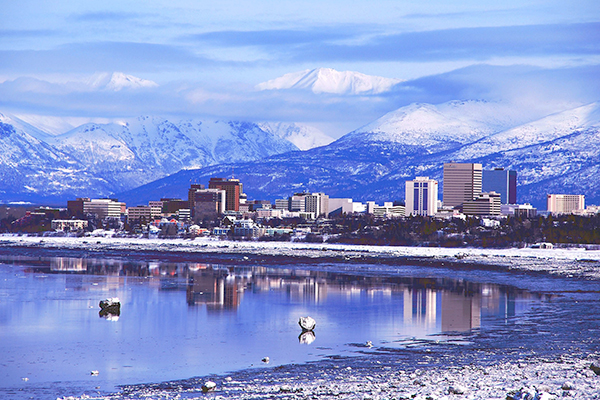Alaska’s tourism brochure writes itself: ‘Alaska – home of glistening glaciers, salmon-saturated rivers and one of the world’s most interesting social policy experiments.’

Just before everyone hops on planes, that last feature in more detail. In the early eighties Alaska governor Jay Hammond initiated the Alaska Permanent Fund Dividend (PFD), a pot of cash generated through excess oil revenues owned collectively by and distributed equally between every resident of the state. As of last year, the fund provided an annual dividend of $2072 per person, paid with no questions asked.
There is much to dislike in the PFD, most obviously the financial disincentive it creates to collective action to reduce Alaska’s carbon footprint. But notwithstanding this queasiness, it’s pretty impressive. A report released last year indicated that it has kept 2-3% of Alaska’s population – some 15-20,000 people – above the poverty line since 1990.
The PFD is of particular interest to followers of the debate around Universal Basic Income, as the only example of a long-term, universal payment to all residents provided irrespective of income or employment status. Eligibility is fairly loose: so long as a person is resident in the state for a full calendar year, intends to stay indefinitely, and doesn’t pick up any criminal convictions in the dividend year, they qualify. While PFD doesn’t replace elements of the existing welfare state in the manner that most proponents suggest a basic income would, its close parallels make it an intriguing case study.
Hence why there were celebrations in the basic income webosphere last week when new survey data (drawn from a sample of over one thousand people) painted a promising picture of the PFD.
Rather than incentivizing laziness or less work – as critics often contend a basic income would – just 1% of employed Alaskans say that the PFD encourages them to work less. While we don’t know exactly what this 1% do with their additional time, it’s a fair guess that at least for some the PFD frees them to do other valuable activities: caring for relatives or learning new skills, for example.
Alaskans also don’t spend their PFD on Playstation games and pizza. Instead, 72% of Alaskans report earmarking their dividends for useful things: essentials, paying off debts, education and saving for retirement or emergencies. It seems that for most Alaskans the PFD provides either a base of security to cover tricky costs or an opportunity for self-investment.
It’s true that the sum of money received via the PFD is relatively speaking not huge, and that the behavioural impacts of a larger basic income – roughly double in the RSA’s own model – might be different. Nonetheless the PFD results provide useful behavioural insights into how people respond to receiving an unconditional payment, with lessons potentially applicable beyond Alaska.
In the same week that the PFD survey results were released, the Trussell Trust released new research on foodbank usage in the UK. The results are frankly pretty grim. 78% of those referred to foodbanks are severely food insecure, meaning that they had gone without eating, perhaps for multiple consecutive days, in the last twelve months.
Two of the key drivers of foodbank use identified are particularly relevant to proponents of basic income. Firstly almost 40% of users are driven to foodbanks as a result of a delayed benefit payment. Second, two thirds of foodbank users had recently been hit by an ‘income shock’, most commonly sharp rises in food or housing costs.
A basic income could address both of these drivers. The unconditional nature prevents people getting caught in delay traps associated with means testing. Moreover just as many Alaskans use their PFD to pay for essentials or save for emergencies, a basic income could support people to be more resilient to unexpected income shocks. Rather than push people through the rigmarole of benefit conditionality and stigma of foodbanks, a basic income could potentially provide people with a firmer foundation from which to live more meaningful lives.
Basic income may not be the right answer, and a degree of scepticism about it and the PFD is healthy. We should ask, for example, whether the PFD money could be more spent in more socially beneficial ways through targeted government programmes. Relatedly, does the use of the PFD by some Alaskans to pay off debts suggest that the payment incentivizes unhealthy consumption habits? These remain open questions, but the PFD results combined with the Trussell Trust revelations suggest a need to at least be willing to consider alternatives to how we currently support our most vulnerable citizens. The basic income experiments being proposed by places like Glasgow and Fife should therefore be enthusiastically supported by the likes of HMRC and the DWP.
Alaska’s PFD provides good evidence that unconditional payments can work, and we should take notice.

Join the discussion
Comments
Please login to post a comment or reply
Don't have an account? Click here to register.
What is not mentioned in this article is that the Alaskan economy is fundamentally different to the UK and most modern states in the West due to its oil revenues.
Unlike corporations, the middle classes and wealthy citizens, who would have to subsidise the basic income, oil cannot pick up leave the country or kick up a political storm.
To fail to make this fundamental distinction in the make up of the economy and the implicit social contract is a significant omission.
Here is a proposal for a variant of UBI that accounts for variants in economic structures: https://docs.google.com/document/d/1EF-Y2LZknP2FBNIMHnQYVRUV5iEu4hpFjvMpcymh3NI/edit?usp=drivesdk
And one I wrote previously on the same subject: https://docs.google.com/document/d/1Uc_xQpLLEmxY1-6GIFerrzMVAFwgVQz66wdDUjHJi4M/edit?usp=drivesdk
It might be useful to know a rough balance of the PFD payment relative to earnings - I didn't see it in the flagged article or the accompanying Executive Memo, and the only data I could find was for 2014 on dear old Wikipedia - and the sources cited didn't seem to reach much agreement.